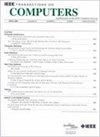Allspark: Workload Orchestration for Visual Transformers on Processing In-Memory Systems
IF 3.6
2区 计算机科学
Q2 COMPUTER SCIENCE, HARDWARE & ARCHITECTURE
引用次数: 0
Abstract
The advent of Transformers has revolutionized computer vision, offering a powerful alternative to convolutional neural networks (CNNs), especially with the local attention mechanism that excels at capturing local structures within the input and achieve state-of-the-art performance. Processing in-memory (PIM) architecture offers extensive parallelism, low data movement costs, and scalable memory bandwidth, making it a promising solution to accelerate Transformer with memory-intensive operations. However, the crucial issue lies in efficiently deploying an entire model onto resource-limited PIM system while parallelizing each transformer block with potentially many computational branches based on local-attention mechanisms. We present Allspark, which focuses on workload orchestration for visual Transformers on PIM systems, aiming at minimizing inference latency. Firstly, to fully utilize the massive parallelism of PIM, Allspark employs a fine-grained partitioning scheme for computational branches, and formats a systematic layout and interleaved dataflow with maximized data locality and reduced data movement. Secondly, Allspark formulates the scheduling of the complete model on a resource-limited distributed PIM system as an integer linear programming (ILP) problem. Thirdly, as local-global data interactions exhibit complex yet regular dependencies, Allspark provides a two-stage placement method, which simplifies the challenging placement of computational branches on the PIM system into the structured layout and greedy-based binding, to minimize NoC communication costs. Extensive experiments on 3D-stacked DRAM-based PIM systems show that Allspark brings求助全文
约1分钟内获得全文
求助全文
来源期刊

IEEE Transactions on Computers
工程技术-工程:电子与电气
CiteScore
6.60
自引率
5.40%
发文量
199
审稿时长
6.0 months
期刊介绍:
The IEEE Transactions on Computers is a monthly publication with a wide distribution to researchers, developers, technical managers, and educators in the computer field. It publishes papers on research in areas of current interest to the readers. These areas include, but are not limited to, the following: a) computer organizations and architectures; b) operating systems, software systems, and communication protocols; c) real-time systems and embedded systems; d) digital devices, computer components, and interconnection networks; e) specification, design, prototyping, and testing methods and tools; f) performance, fault tolerance, reliability, security, and testability; g) case studies and experimental and theoretical evaluations; and h) new and important applications and trends.
 求助内容:
求助内容: 应助结果提醒方式:
应助结果提醒方式:


